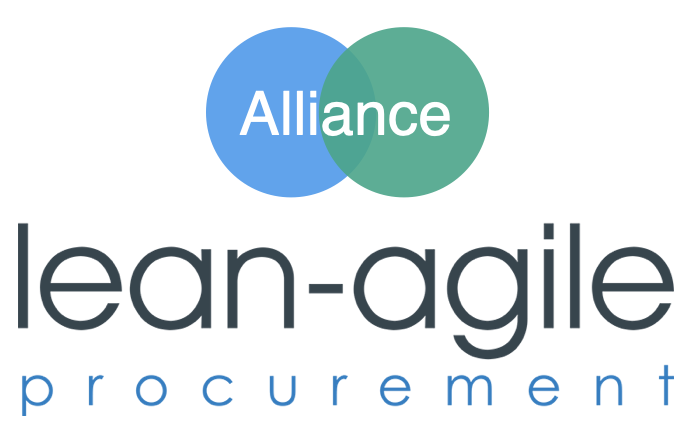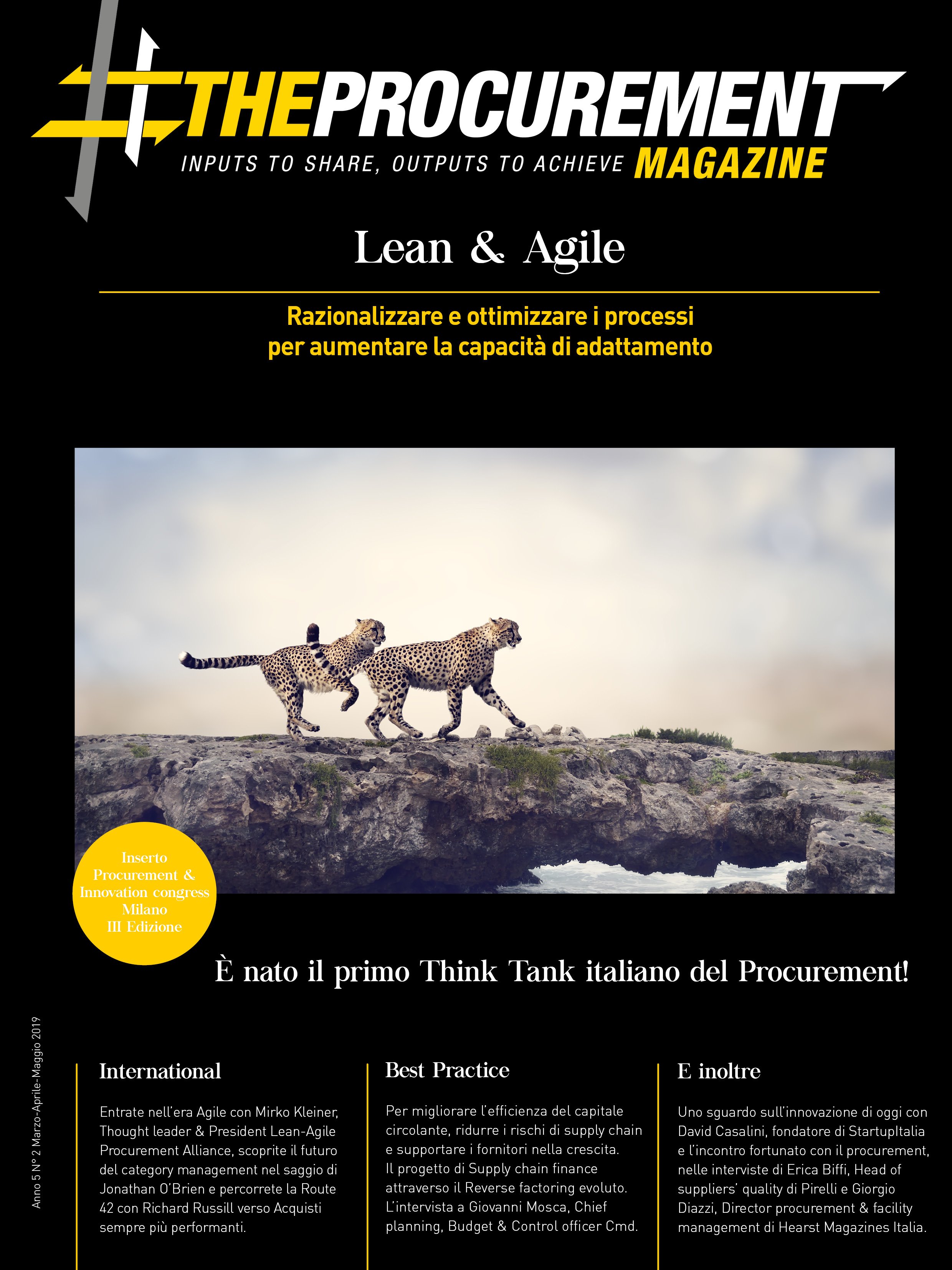Keynote Article in THE PROCUREMENT MAGAZINE - This is the dawning of the age of agility
This Article has got published in THE PROCUREMENT MAGAZINE 2019-05 as lead article. It was also hand-out at their procurement awards. A big thanks goes to Micol Barba, Editorial Manager - Editor in chief at THE PROCUREMENT ITALIA, who is a strong supporter of our movement Lean-Agile Procurement!
Lets change the game
with Lean-Agile Procurement
by Mirko Kleiner & Philipp Engstler
This Article has got published in THE PROCUREMENT MAGAZINE 2019-05 as lead article. It was also hand-out at their procurement awards. A big thanks goes to Micol Barba, Editorial Manager - Editor in chief at THE PROCUREMENT ITALIA, who is a strong supporter of our movement Lean-Agile Procurement!
Not just a new approach, but a new mindset, even a new age is needed to cope with the upcoming market demands. Cases using this new mindset have been proofed to source complex cases in as little as one day! No wonder do companies such as Barclays, Gazprom, Air France, etc. radically tran- sform their organisation and so their strategic procurement.
We live in an exciting, rapidly developing world where it’s possible, for example, to print an aircraft engine within 72 hours (1). Commodity sourcing cases are increasin- gly digitized or taken over by machines. That leaves the complex, mostly strategic sourcing cases for which our existing tools such as Rfi, Rfp, Reverse Auction, etc. are inadequate (2).
In other words, we need new approaches to deliver added value to the business fa- ster and so to stay relevant as procurement
“It’s a matter of delivering fast added value as procurement”
How do we meet the challenges of in- creasing complexity and the demand for rapid time-to-market? The startup scene has already shown how it can be done. They use approaches such as Lean Startup (3), Scrum/Agile (4), or the Bu- siness Model Canvas (5), and they have absorbed uncertainty into their DNA. Benefiting from their experience, lean-agi- le procurement (6) opens up completely new possibilities for procurement, sales and partner management.
DESIGNED FOR ADAPTIVE, STRATEGIC SOURCING
Lean-Agile Procurement is an approach that can be used in both direct and indirect sourcing (6). Originally developed for the sourcing of agile development teams in di- gitalization, it is now used in all categories and industries (2).
The prerequisite is a high level of com- plexity in terms of sourcing content or organization, which is usually the case in strategic sourcing. It is unsuitable for com- modity sourcing, where it may even gene- rate unnecessary overhead.
Barclays for example has started begin of 2018 to organize more than 100 people in pods (stable, cross-functional) teams. Idea is that these pods could handle complex, strategic cases as team much faster, than handing them over and over again. Their numbers showed, that they were able to increase lead time radically.
FOUR TIMES FASTER FROM IDEA TO FIRST VALUE DELIVERED
The awarded success story of the CKW Group (7), an energy company in Switzer- land with 1,700 employees and a turnover of ~850 million, showed that with Lean-Agile Procurement complex sourcing cases can be successfully processed in 4-5 weeks.
While this could be done twice as fast without a problem as this included team setup, learning on the job, etc. Even though this represents four times faster time-to-market compared to classic ap- proaches (4). New ideas can be introduced and tested in the market much faster, and the generated return occurs much earlier. Companies applying Lean-Agile Procure- ment have a competitive advantage with direct impact on the company’s success. From a customer perspective this means a much faster availability of new services and/or products and high reduction of cost-of-delay. Focusing on time-to-market changes everything for procurement!
“This is a game changer”
~80% SAVINGS THROUGH ALIGNMENT AND FOCUS
In complex sourcing cases, especially strategic sourcing, there is a very high de- gree of uncertainty as to what the custo- mer or market needs (8). This makes it all the more important to focus first on the most important business goals (why) and customer needs (what), and only after that on solutions or products (how).
During the development of a new busi- ness case we should already be entering into an intensive interaction with our custo- mers and continuously collecting feedback (3). Instead of creating huge specification documents it’s recommanded to have e.g. representatives of all customer segments in one room and directly ask them for their needs, priority, etc., we are using the Lean Procurement Canvas(6) to capture this. By consistently focusing on the most impor- tant customer needs we simultaneously increase our alignment, push nice-to-ha- ve’s to the back of the queue, and minimize unnecessary effort (4).
RADICAL RISK REDUCTION THROUGH ADAPTABILITY
Tighter focus leads to smaller batches, which allow for increasingly faster sour- cing, which in turn makes it possible to prolong or even change a partner/product/ etc. more easily (6). The overheads incur- red by suppliers, legal, etc. are reduced and incremental deliveries ensure a fun- ctional solution at all times. The fact that customer feedback is collected after each iteration ensures that the solution meets the initial expectations. This requires new, more agile contracts (9) with which a part- nership can be adapted, or even stopped, at any time. This radically reduces risk.
Current cases that applied this principle e.g. co-created the contract with their po- tential partners in one room simultanuo- usly. Doing so open questions, concerns could have been resolved immediately. Even more than that cost drivers could have been identified much earlier and adapted jointly even before starting the cooperation.
~50% MORE EFFICIENT ECONOMICALLY
Complex sourcing cases are corre- spondingly complex to implement. With Lean-Agile Procurement we reduce the overheads on the buyer side by an average of 50% (2). This is mainly achieved by set- ting up a cross-functional team of experts, that can do the job. Having an empowered team together reduces decision-latency to the minimum, so that things develop much faster.
The reduction of effort on the suppliers’ side should also not be underestimated. From an economic point of view, what we are achieving is an optimization of non-va- lue-adding work (10), which ultimately has a direct effect on market performance and the associated success of the company.
COLLABORATION INCREASES INNOVATION
Uncertainty about customer needs can only be minimized through direct inte- raction with customers and users. Consul- tation occurs not just once, but continues throughout the entire procurement process and beyond. Not just the customers but the providers too are included and bring their ideas into the discussion.
A common understanding of customer needs leads to simpler solutions, better collaboration, and new ideas (2). That’s why it’s recommended to ask for a joint wor- kshop with the potential partner/s, where both parties bring in the people that might cooperate and do the job.
Being agile is a mindset and we need to ensure even before we go into a partner- ship, that we have a social fit too. Often we run a proof-of-concept in parallel to the co-creation of an agile contract. This way the delivery capabilities and the behaviors of the people in the room could be obser- ved while actually working. If we invite e.g. at the end of each day the real users we even get direct feedback for new innovative ideas implemented.
TRUE PARTNERSHIP — BOTH SIDES WIN
Strategic sourcing is a two-way street. It requires an attitude of trust cooperation based on partnership and shared values (6). Binding contracts and cost focus are usually to the disadvantage of one party and do not lead to a genuine partnership.
While in Lean-Agile Procurement the hard facts of quality, costs, etc. remain important, social facts, such as the beha- viour of potential suppliers in concrete si- tuations, become just as important, if not more so, as issues are worked out during contract fullfillment.
This leads to fundamental changes in behaviour not only towards partners but also within the company itself (10). This has consequences for the reputation, loyalty, and indirectly also for the motivation and work performance of each individual em- ployee (2).
In one case a new ERP has got sourced in just two days (!) with three potential part- ners in one room simulaneously. The buyer side decided as a team for one partner, but asked for another person from another competitor to join their team. This wouldn’t be possible sending papers back-n-forth.
HIGHER PRODUCTIVITY
Lean-Agile Procurement makes the exi- sting sourcing process more efficient, whi- le focusing on being more effective – doing the right things. In an uncertain environ- ment (8) this also means saying goodbye to detailed specifications, and accepting that anything can change at any time. In today’s smart business development scene the Business Model Canvas (5) is a living document and 100-page business cases are a thing of the past. With Lean-Agile Procurement we demand the same, and the Lean Procurement Canvas provides it.
“Speed is the new currencyof business”
EARLIER RETURN AND FAST FEEDBACK CYCLES IS MORE IMPORTANT THAN COSTS
With innovative ideas, it is more important to learn from customer feedback and to be ahead of the competition than to optimize the last few percent of costs. Because we are only sourcing in small batches, the risk of a bad investment remains small (3).
It’s not any more a question if agile will become a topic for procurement, then in most companies agile transformation pro- grams are already in progress. Full stack business agility require an agile acting procurement departmenet, start experi- ments with agile practices, approaches such as Lap and see what of it makes sen- se in your context.
Lean-Agile Procurement is a proven ap- proach for indirect and direct sourcing in all categories where the sourcing case has a certain complexity. Applied in commodity sourcing cases it creates unnecessary overhead.
It is a practical approach that improves time-to-market significantly and radically decreases risk through incremental and value-added funding for improved busi- ness outcomes.
Lean-Agile Procurement has a sustainable impact on the way we work together, both internally and with our partners – because the soft facts are evaluated by the very people who are going to be working together.
With Lean-Agile Procurement it is once again possible to deliver added value to the business faster and thus remain relevant as procurement.
For more information go to: https://www. lean-agile-procurement.com
Magazine
To order the magazine goto:
The original article could be download here:
https://drive.google.com/open?id=1EyJC-MLPJqsfTM99dbZYI2A7fo5RUY1f
Autors
(1) Additive Manufacturing, GE 2016
(2) Survey/research about agile@procure-ment & sales, flowdays, Switzerland, 2018(3) The lean startup by Eric Ries
(4) For example: “Twice the work in half of thetime” by Dr. Jeff Sutherland, co-creator of SCRUM, author and founder of Scrum Inc.(5) Business Model Canvas, Alex Osterwalder(6) lean-procurement.com & Lean Procure-ment Canvas by Mirko Kleiner, flowdays
(7) “CKW case study”, CKW & flowdays, 2018 (8) Complexity theory by R. Stacey, 2019
(9) See agile contracts at e.g. http://www. flexiblecontracts.com
or http://www.vestedway.com, 2019
(10) Decision latency, www.scrumatscale. com 2019 (11) Pull system by Lean Manu-facturing 2019”

